Answered step by step
Verified Expert Solution
Question
1 Approved Answer
please explainations too (second and third photos are more clear) **updated Introduction: Case Study Surgical Robot Arms Race In the greater Sattle-Tacoma a a a
please explainations too
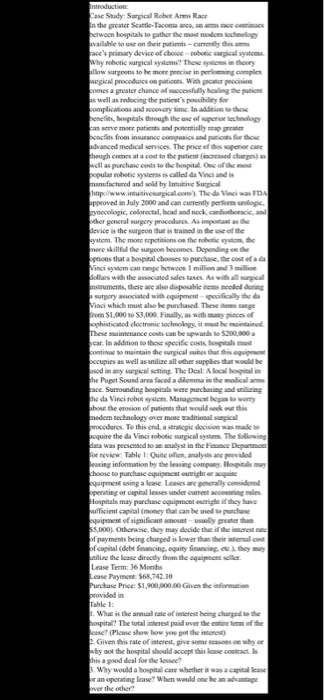
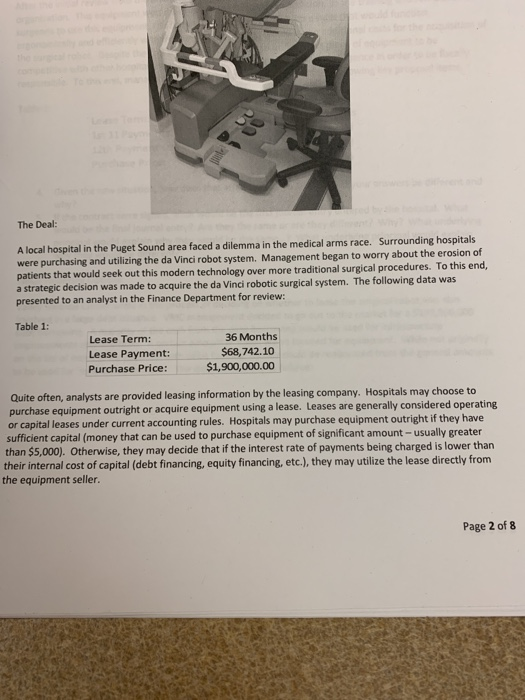
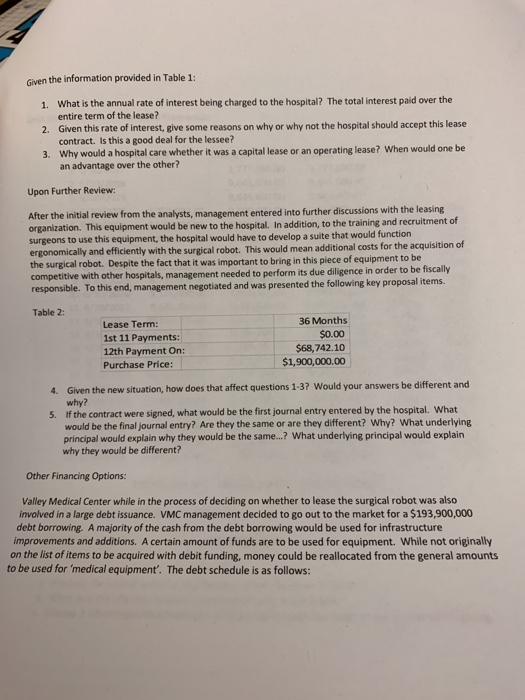
(second and third photos are more clear)
**updated 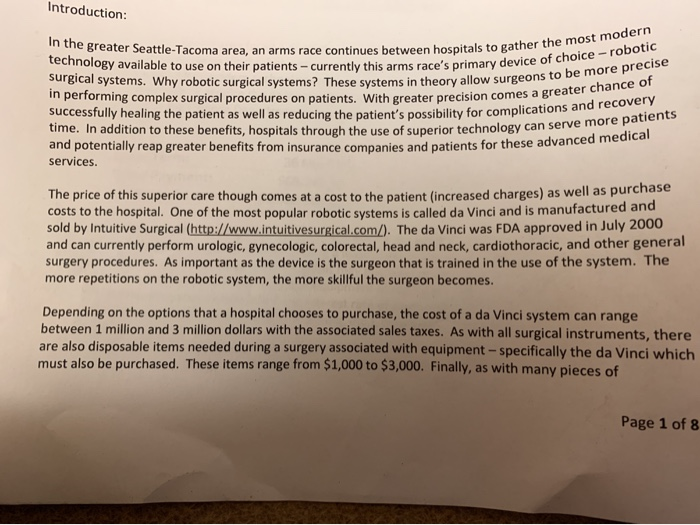
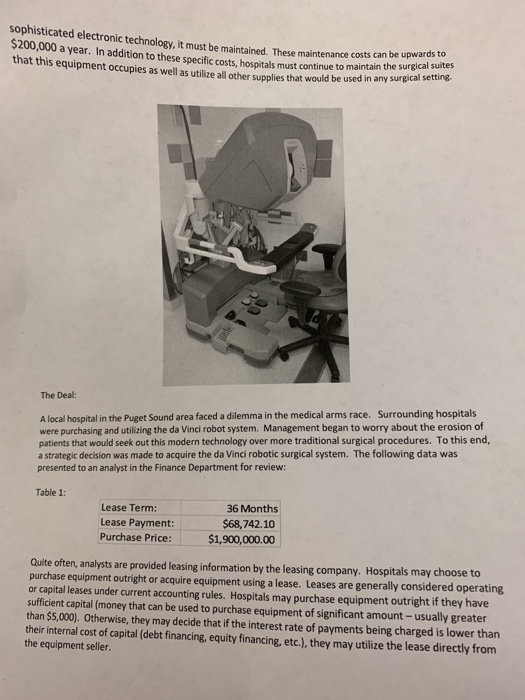
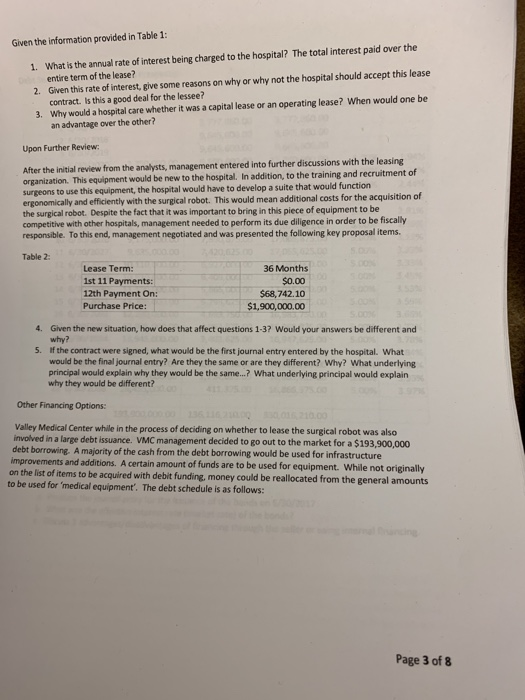
Introduction: Case Study Surgical Robot Arms Race In the greater Sattle-Tacoma a a a ace s petween hospitals to gather the most demo logy available to use on their patients and his ace's primary device of choice - robotic surgical systems Why robotic surgical systems? These they allow warens to be more precise in peric o le surgical procedures on patients with a pro comes a greater chance of successfully healing the line as well as reducing the patient's possibility for complications and our time. In addition to these penefits, hospitals through the use of technology serve more patients and potentially a great ancies from insurance comics and paints for those bidvanced medical services. The price of th e care hough comes at a cost to the patient e d charpes well as purchase costs to the hospital. One of the most popular robotic systems is called da Vinci and is manufactured and sold by l ive Surgical http/www.inctivewurgical Theda Vinci wa FDA approved in July 2000 and can currently perform logic gynecologic, colorectal head and neck cantocic, and her general surgery procedures, Asiman as the device is the surgeon this trained in the use of the System. The more repetitions on the robotic to the more skill the surgeon homes. Depending on the ptions that a hospital choose to purchase the cost of a Vinci system can rangeboten million and Jollars with the associated sales taxes. As with all surgical instruments, there are also disposable cool during surgery a cted with i specifically the Vinci which must also be purchased Thess age Free S1.000 10 $3,000. Finally, as with m y of sophisticated clectronic technology, t he m ind These maintenance costs can be upward to $200,000 a Year. In addition to these specific costs, hospitals continue to maintain the surgical sites that this pocupies as well as utilize all other supplies that would be used in any surgical setting. The Deal: A local hot in The Puget Sound area faced a dilemma in the medicala ace. Surrounding hospitals were purchasing a n g he da Vinci robot system Manapomwa m y about the erosion of patients that would seek this aden ochnology norme vaditional surgical unes, Te this end, a de a d quire the da Vinci robotic surgical system. The following at was presented to in the Finance Dep ! w Table 1: Ouite on analyse d d Leasing information by the leasing comp letely Lhoose to purchase equipment util i se quipment using a lean L e ly considered Operating or capital leases under cum ingles Hospitals may purchase equipment utright they have ufficient capital money that can be used to purchase Equipement of significant per 5.000). Otherwise, they may decide the theme of payments being charged is lower than the malo of capital (debe facing equity financing the time the lease directly from the ea s ier Lease Term: 36 Meers case Payment: $ 6 410 Purchase Price: $1,900,000.00 Given the format provided in Table 1: 1. What is the annual rate of being charged to the hospital? The total interest paid over the tem of the Reese (Please show how you got the st) 2. Given this rate of interest give some why y not the hospital should wept this lease contacts this a good deal for the lesso? Why would a hospital care whether its capitales or an operating lase? When would one he ana p e per the other The Deal: A local hospital in the Puget Sound area faced a dilemma in the medical arms race. Surrounding hospitals were purchasing and utilizing the da Vinci robot system. Management began to worry about the erosion of patients that would seek out this modern technology over more traditional surgical procedures. To this end, a strategic decision was made to acquire the da Vinci robotic surgical system. The following data was presented to an analyst in the Finance Department for review: Table 1: Lease Term: Lease Payment: Purchase Price: 36 Months $68,742.10 $1,900,000.00 Quite often, analysts are provided leasing information by the leasing company. Hospitals may choose to purchase equipment outright or acquire equipment using a lease. Leases are generally considered operating or capital leases under current accounting rules. Hospitals may purchase equipment outright if they have sufficient capital (money that can be used to purchase equipment of significant amount-usually greater than $5,000). Otherwise, they may decide that if the interest rate of payments being charged is lower than their internal cost of capital (debt financing, equity financing, etc.), they may utilize the lease directly from the equipment seller. Page 2 of 8 Introduction: the greater Seattle-Tacoma area, an arms race continues between hospitals to gathe technology available to use on their patients - currently this arms race's primary device surgical systems. Why robotic surgical systems? These systems in theory di in performing complex surgical procedures on patients. With greater precision comes a gree successfully healing the patient as well as reducing the patient's possibility vell as reducing the patient's possibility for complications and recovery time. In addition to these benefits, hospitals through the use of serve more patients tion to these benefits, hospitals through the use of superior technology can serve more advanced medical potentially reap greater benefits from insurance companies and patients for these advance services. hospitals to gather the most modern 's primary device of choice - robotic ese systems in theory allow surgeons to be more precise ecision comes a greater chance of ine price of this superior care though comes at a cost to the natient increased charges) as well as pum costs to the hospital. One of the most popular robotic systems is called da Vinci and is manufactured and sold by Intuitive Surgical (http://www.intuitivesurgical.com/). The da Vinci was FDA approved in July 2000 and can currently perform urologic, gynecologic, colorectal, head and neck, cardiothoracic, and other general surgery procedures. As important as the device is the surgeon that is trained in the use of the system. The more repetitions on the robotic system, the more skillful the surgeon becomes. Depending on the options that a hospital chooses to purchase, the cost of a da Vinci system can range between 1 million and 3 million dollars with the associated sales taxes. As with all surgical instruments, there are also disposable items needed during a surgery associated with equipment - specifically the da Vinci which must also be purchased. These items range from $1,000 to $3,000. Finally, as with many pieces of Page 1 of 8 sophisticated electronic technolo ed electronic technology, it must be maintained. These maintenance costs can be upwa $200,000 a year. In addition to these specific costs, hospitals must continue to maintam that this equipment occupies as well as utilize all other supplies that would be used in any surge ce costs can be upwards to st continue to maintain the surgical suites The Deal: A local hospital in the Puget Sound area faced a dilemma in the medical arms race. Surrounding hospitals were purchasing and utilizing the da Vinci robot system. Management began to worry about the erosion of patients that would seek out this modern technology over more traditional surgical procedures. To this end, a strategic decision was made to acquire the da Vinci robotic surgical system. The following data was presented to an analyst in the Finance Department for review: Table 1: Lease Term: Lease Payment: Purchase Price: 36 Months $68,742.10 $1,900,000.00 Quite often, analysts are provided leasing information by the leasing company. Hospitals may choose to purchase equipment outright or acquire equipment using a lease. Leases are generally considered operating or capital leases under current accounting rules. Hospitals may purchase equipment outright if they have sufficient capital (money that can be used to purchase equipment of significant amount-usually greater than $5,000). Otherwise, they may decide that if the interest rate of payments being charged is lower than their internal cost of capital (debt financing, equity financing, etc.), they may utilize the lease directly from the equipment seller. Given the information provided in Table 1: 1. What is the annual rate of interest being charged to the hospital? The total interest paid over the entire term of the lease? 2. Given this rate of interest, give some reasons on why or why not the hospital should accept this lease contract. Is this a good deal for the lessee? 3. Why would a hospital care whether it was a capital lease or an operating lease? When would one be an advantage over the other? Upon Further Review: After the initial review from the analysts, management entered into further discussions with the leasing organization. This equipment would be new to the hospital. In addition, to the training and recruitment of Surgeons to use this equipment, the hospital would have to develop a suite that would function ergonomically and efficiently with the surgical robot. This would mean additional costs for the acquisition of the surgical robot. Despite the fact that it was important to bring in this piece of equipment to be competitive with other hospitals, management needed to perform its due diligence in order to be fiscally responsible. To this end, management negotiated and was presented the following key proposal items. Table 2: Lease Term: 1st 11 Payments: 12th Payment On: Purchase Price: 36 Months $0.00 $68,742.10 $1,900,000.00 4. Given the new situation, how does that affect questions 1-3? Would your answers be different and why? 5. If the contract were signed, what would be the first journal entry entered by the hospital. What would be the final journal entry? Are they the same or are they different? Why? What underlying principal would explain why they would be the same...? What underlying principal would explain why they would be different? Other Financing Options: Valley Medical Center while in the process of deciding on whether to lease the surgical robot was also involved in a large debt issuance. VMC management decided to go out to the market for a $193,900,000 debt borrowing. A majority of the cash from the debt borrowing would be used for infrastructure improvements and additions. A certain amount of funds are to be used for equipment. While not originally on the list of items to be acquired with debit funding, money could be reallocated from the general amounts to be used for 'medical equipment'. The debt schedule is as follows: Page 3 of 8 Introduction: Case Study Surgical Robot Arms Race In the greater Sattle-Tacoma a a a ace s petween hospitals to gather the most demo logy available to use on their patients and his ace's primary device of choice - robotic surgical systems Why robotic surgical systems? These they allow warens to be more precise in peric o le surgical procedures on patients with a pro comes a greater chance of successfully healing the line as well as reducing the patient's possibility for complications and our time. In addition to these penefits, hospitals through the use of technology serve more patients and potentially a great ancies from insurance comics and paints for those bidvanced medical services. The price of th e care hough comes at a cost to the patient e d charpes well as purchase costs to the hospital. One of the most popular robotic systems is called da Vinci and is manufactured and sold by l ive Surgical http/www.inctivewurgical Theda Vinci wa FDA approved in July 2000 and can currently perform logic gynecologic, colorectal head and neck cantocic, and her general surgery procedures, Asiman as the device is the surgeon this trained in the use of the System. The more repetitions on the robotic to the more skill the surgeon homes. Depending on the ptions that a hospital choose to purchase the cost of a Vinci system can rangeboten million and Jollars with the associated sales taxes. As with all surgical instruments, there are also disposable cool during surgery a cted with i specifically the Vinci which must also be purchased Thess age Free S1.000 10 $3,000. Finally, as with m y of sophisticated clectronic technology, t he m ind These maintenance costs can be upward to $200,000 a Year. In addition to these specific costs, hospitals continue to maintain the surgical sites that this pocupies as well as utilize all other supplies that would be used in any surgical setting. The Deal: A local hot in The Puget Sound area faced a dilemma in the medicala ace. Surrounding hospitals were purchasing a n g he da Vinci robot system Manapomwa m y about the erosion of patients that would seek this aden ochnology norme vaditional surgical unes, Te this end, a de a d quire the da Vinci robotic surgical system. The following at was presented to in the Finance Dep ! w Table 1: Ouite on analyse d d Leasing information by the leasing comp letely Lhoose to purchase equipment util i se quipment using a lean L e ly considered Operating or capital leases under cum ingles Hospitals may purchase equipment utright they have ufficient capital money that can be used to purchase Equipement of significant per 5.000). Otherwise, they may decide the theme of payments being charged is lower than the malo of capital (debe facing equity financing the time the lease directly from the ea s ier Lease Term: 36 Meers case Payment: $ 6 410 Purchase Price: $1,900,000.00 Given the format provided in Table 1: 1. What is the annual rate of being charged to the hospital? The total interest paid over the tem of the Reese (Please show how you got the st) 2. Given this rate of interest give some why y not the hospital should wept this lease contacts this a good deal for the lesso? Why would a hospital care whether its capitales or an operating lase? When would one he ana p e per the other The Deal: A local hospital in the Puget Sound area faced a dilemma in the medical arms race. Surrounding hospitals were purchasing and utilizing the da Vinci robot system. Management began to worry about the erosion of patients that would seek out this modern technology over more traditional surgical procedures. To this end, a strategic decision was made to acquire the da Vinci robotic surgical system. The following data was presented to an analyst in the Finance Department for review: Table 1: Lease Term: Lease Payment: Purchase Price: 36 Months $68,742.10 $1,900,000.00 Quite often, analysts are provided leasing information by the leasing company. Hospitals may choose to purchase equipment outright or acquire equipment using a lease. Leases are generally considered operating or capital leases under current accounting rules. Hospitals may purchase equipment outright if they have sufficient capital (money that can be used to purchase equipment of significant amount-usually greater than $5,000). Otherwise, they may decide that if the interest rate of payments being charged is lower than their internal cost of capital (debt financing, equity financing, etc.), they may utilize the lease directly from the equipment seller. Page 2 of 8 Introduction: the greater Seattle-Tacoma area, an arms race continues between hospitals to gathe technology available to use on their patients - currently this arms race's primary device surgical systems. Why robotic surgical systems? These systems in theory di in performing complex surgical procedures on patients. With greater precision comes a gree successfully healing the patient as well as reducing the patient's possibility vell as reducing the patient's possibility for complications and recovery time. In addition to these benefits, hospitals through the use of serve more patients tion to these benefits, hospitals through the use of superior technology can serve more advanced medical potentially reap greater benefits from insurance companies and patients for these advance services. hospitals to gather the most modern 's primary device of choice - robotic ese systems in theory allow surgeons to be more precise ecision comes a greater chance of ine price of this superior care though comes at a cost to the natient increased charges) as well as pum costs to the hospital. One of the most popular robotic systems is called da Vinci and is manufactured and sold by Intuitive Surgical (http://www.intuitivesurgical.com/). The da Vinci was FDA approved in July 2000 and can currently perform urologic, gynecologic, colorectal, head and neck, cardiothoracic, and other general surgery procedures. As important as the device is the surgeon that is trained in the use of the system. The more repetitions on the robotic system, the more skillful the surgeon becomes. Depending on the options that a hospital chooses to purchase, the cost of a da Vinci system can range between 1 million and 3 million dollars with the associated sales taxes. As with all surgical instruments, there are also disposable items needed during a surgery associated with equipment - specifically the da Vinci which must also be purchased. These items range from $1,000 to $3,000. Finally, as with many pieces of Page 1 of 8 sophisticated electronic technolo ed electronic technology, it must be maintained. These maintenance costs can be upwa $200,000 a year. In addition to these specific costs, hospitals must continue to maintam that this equipment occupies as well as utilize all other supplies that would be used in any surge ce costs can be upwards to st continue to maintain the surgical suites The Deal: A local hospital in the Puget Sound area faced a dilemma in the medical arms race. Surrounding hospitals were purchasing and utilizing the da Vinci robot system. Management began to worry about the erosion of patients that would seek out this modern technology over more traditional surgical procedures. To this end, a strategic decision was made to acquire the da Vinci robotic surgical system. The following data was presented to an analyst in the Finance Department for review: Table 1: Lease Term: Lease Payment: Purchase Price: 36 Months $68,742.10 $1,900,000.00 Quite often, analysts are provided leasing information by the leasing company. Hospitals may choose to purchase equipment outright or acquire equipment using a lease. Leases are generally considered operating or capital leases under current accounting rules. Hospitals may purchase equipment outright if they have sufficient capital (money that can be used to purchase equipment of significant amount-usually greater than $5,000). Otherwise, they may decide that if the interest rate of payments being charged is lower than their internal cost of capital (debt financing, equity financing, etc.), they may utilize the lease directly from the equipment seller. Given the information provided in Table 1: 1. What is the annual rate of interest being charged to the hospital? The total interest paid over the entire term of the lease? 2. Given this rate of interest, give some reasons on why or why not the hospital should accept this lease contract. Is this a good deal for the lessee? 3. Why would a hospital care whether it was a capital lease or an operating lease? When would one be an advantage over the other? Upon Further Review: After the initial review from the analysts, management entered into further discussions with the leasing organization. This equipment would be new to the hospital. In addition, to the training and recruitment of Surgeons to use this equipment, the hospital would have to develop a suite that would function ergonomically and efficiently with the surgical robot. This would mean additional costs for the acquisition of the surgical robot. Despite the fact that it was important to bring in this piece of equipment to be competitive with other hospitals, management needed to perform its due diligence in order to be fiscally responsible. To this end, management negotiated and was presented the following key proposal items. Table 2: Lease Term: 1st 11 Payments: 12th Payment On: Purchase Price: 36 Months $0.00 $68,742.10 $1,900,000.00 4. Given the new situation, how does that affect questions 1-3? Would your answers be different and why? 5. If the contract were signed, what would be the first journal entry entered by the hospital. What would be the final journal entry? Are they the same or are they different? Why? What underlying principal would explain why they would be the same...? What underlying principal would explain why they would be different? Other Financing Options: Valley Medical Center while in the process of deciding on whether to lease the surgical robot was also involved in a large debt issuance. VMC management decided to go out to the market for a $193,900,000 debt borrowing. A majority of the cash from the debt borrowing would be used for infrastructure improvements and additions. A certain amount of funds are to be used for equipment. While not originally on the list of items to be acquired with debit funding, money could be reallocated from the general amounts to be used for 'medical equipment'. The debt schedule is as follows: Page 3 of 8 


Step by Step Solution
There are 3 Steps involved in it
Step: 1

Get Instant Access to Expert-Tailored Solutions
See step-by-step solutions with expert insights and AI powered tools for academic success
Step: 2

Step: 3

Ace Your Homework with AI
Get the answers you need in no time with our AI-driven, step-by-step assistance
Get Started


